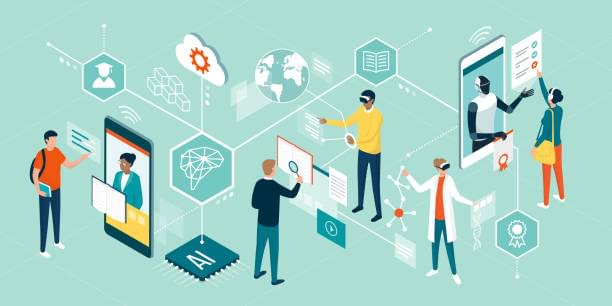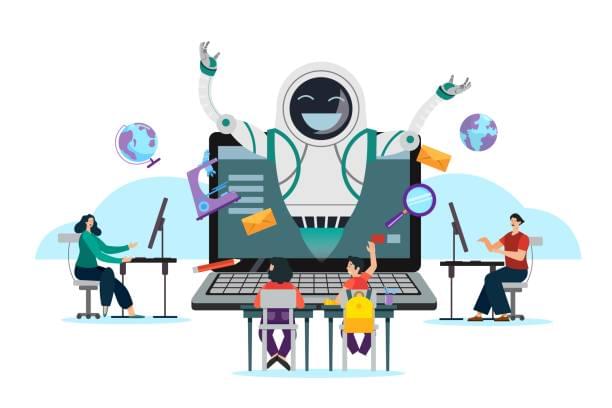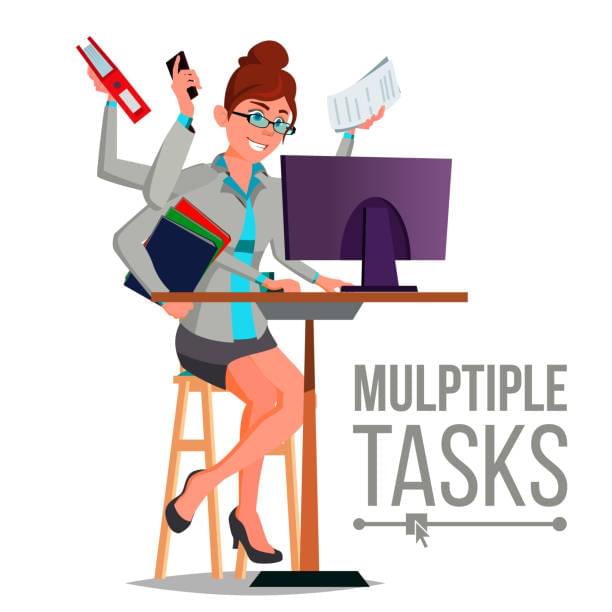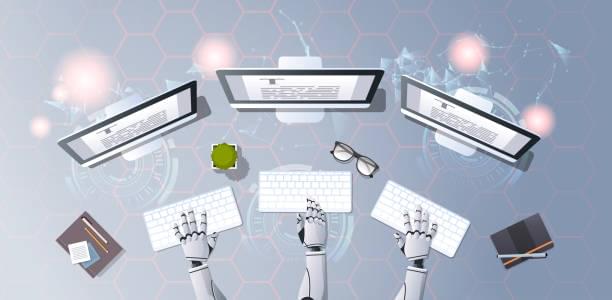Imagine walking into a classroom where every student gets a personalized learning experience tailored to their unique needs—thanks to artificial intelligence (AI). Sounds futuristic, right? Well, the future is already here. AI is transforming education in ways we never thought possible, making learning more accessible, engaging, and effective. From personalized lesson plans to virtual tutors, available 24/7, AI in education is reshaping how we teach and learn. In this article, we’ll explore the groundbreaking ways AI is revolutionizing education and what it means for students, teachers, and the future of learning.
1. Personalized Learning: Tailoring Education to Every Student

One of the most exciting applications of AI in education is personalized learning. Traditional classrooms often follow a one-size-fits-all approach, but AI changes that by analyzing each student’s strengths, weaknesses, and learning pace. For example, platforms like Khan Academy use AI algorithms to adapt lessons based on how well a student performs on quizzes and exercises. If a student struggles with fractions, the system provides additional practice problems and explanations until they master the concept.
This level of customization ensures that no student gets left behind. It also helps advanced learners move ahead at their own speed, keeping them engaged and challenged. With artificial intelligence in learning, education becomes less about memorization and more about understanding.
2. Intelligent Tutoring Systems: Your Virtual Tutor is Here

Ever wished you had a tutor available anytime, anywhere? AI-powered tutoring systems make that dream a reality. Tools like Socratic by Google allow students to ask questions and receive step-by-step explanations instantly. Whether it’s solving a math problem or understanding a complex science concept, these virtual tutors provide immediate feedback without judgment.
For instance, if a high schooler is stuck on algebra homework late at night, they can simply snap a photo of the problem, and Socratic will break it down into manageable steps. This not only boosts confidence but also encourages independent learning. These AI-powered education tools are proving to be invaluable resources for students who need extra support outside the classroom.
3. Automating Administrative Tasks: Giving Teachers Their Time Back

Let’s face it—teachers spend countless hours grading papers, tracking attendance, and planning lessons. AI is stepping in to lighten the load. Platforms like Gradescope use AI to automate grading for assignments and exams, freeing up educators to focus on what they do best: teaching.
Similarly, tools like Turnitin help detect plagiarism and ensure academic integrity, saving teachers even more time. By automating these repetitive tasks, AI allows educators to dedicate more energy to creating meaningful learning experiences. After all, shouldn’t teachers be spending their time inspiring students rather than buried under paperwork?
4. Accessibility and Inclusivity: Breaking Barriers in Education
AI is also playing a crucial role in making education more inclusive. For students with disabilities, AI-powered tools are game-changers. Take Microsoft Immersive Reader, for example. This tool helps students with dyslexia or visual impairments read and comprehend text by adjusting font sizes, spacing, and colors. It even reads aloud, making written content accessible to those who struggle with traditional formats.
Speech-to-text technologies and AI-driven captioning tools are helping deaf and hard-of-hearing students participate fully in classroom discussions. By removing barriers, AI in education ensures that every learner has an equal opportunity to succeed.
5. AI-Powered Content Creation: Helping Educators Work Smarter

Creating engaging educational materials can be time-consuming, but AI is here to help. Tools like Jasper and Canva’s Magic Design allow educators to generate quizzes, worksheets, and interactive presentations in minutes. For example, a history teacher could input key events from World War II, and Jasper would create a timeline or quiz based on that information.
These tools don’t just save time—they also ensure high-quality, visually appealing content that captures students’ attention. With AI-powered education tools, educators can focus on delivering impactful lessons instead of getting bogged down in prep work.
6. Predictive Analytics for Student Success: Early Intervention Matters
Predictive analytics is another area where AI shines. By analyzing data such as attendance records, test scores, and participation rates, AI can identify students who may be at risk of falling behind. Platforms like BrightBytes and Panorama Education use machine learning to recommend interventions before issues escalate.
For example, if students’ grades start dropping and their attendance becomes irregular, the system might suggest counseling or tutoring services. This proactive approach helps schools address problems early, improving retention rates and overall student success.
7. Gamification and Engagement: Making Learning Fun
Who says learning has to be boring? AI is bringing gamification to the forefront of education. Platforms like Classcraft turn classrooms into immersive games where students earn points for completing assignments, participating in discussions, and collaborating with peers. The result? Increased motivation and participation.
Gamified learning isn’t just for kids, either. Apps like Duolingo use AI to make language learning addictive for adults by rewarding progress and offering bite-sized lessons. When learning feels like play, students are more likely to stick with it.
8. Global Access to Education: Bridging the Gap
AI is democratizing education by providing access to quality learning resources worldwide. Online platforms like Coursera , edX , leverage AI to offer courses in multiple languages and cater to diverse learning styles. A student in rural India can now take a course taught by a professor at Harvard—all thanks to AI.
This global reach is particularly important for underserved communities. By breaking down geographical and financial barriers, AI in education is helping create a more equitable world.
9. Ethical Considerations: Balancing Innovation with Responsibility
While AI offers incredible benefits, it’s not without challenges. Data privacy is a major concern, as many AI tools collect sensitive information about students. Additionally, algorithmic bias can lead to unfair outcomes if the data used to train these systems isn’t diverse enough.
To address these issues, educators and policymakers must prioritize transparency and accountability. For example, schools should clearly communicate how student data is collected and used. Responsible implementation of artificial intelligence in learning ensures that technology serves as a tool for empowerment, not exploitation.
10. Future Trends in AI and Education: What’s Next?
The future of AI in education looks bright. Emerging technologies like virtual reality (VR) classrooms could soon become mainstream, allowing students to explore ancient civilizations or conduct virtual science experiments. AI-driven career counseling platforms may help students discover their passions and align them with potential careers.
As AI continues to evolve, its role in education will only grow. The key is to embrace these innovations while staying mindful of their ethical implications.
Conclusion
Artificial intelligence is revolutionizing education in once unimaginable ways. From personalized learning paths to virtual tutors and predictive analytics, AI in education is empowering both students and teachers to achieve more. However, as we embrace these advancements, it’s essential to balance innovation with responsibility.
As AI continues to transform education, staying informed is crucial. How do you think AI will shape the future of learning? Share your thoughts in the comments below!
FAQ Section
- Q: How does AI personalize learning?
A: AI analyzes student performance and adapts content to meet individual needs, ensuring a customized learning experience. - Q: Are AI tools replacing teachers?
A: No, AI complements teachers by automating repetitive tasks and enhancing learning experiences, allowing educators to focus on teaching. - Q: Is AI in education accessible to everyone?
A: Yes, platforms like Coursera and BYJU’S are making AI-driven education accessible globally, bridging gaps for underserved communities. - Q: What are some examples of AI-powered education tools?
A: Popular tools include Khan Academy, Socratic by Google, Gradescope, Turnitin, and Microsoft Immersive Reader. - Q: How does AI help with accessibility in education?
A: AI tools like speech-to-text, captioning, and adaptive interfaces make learning accessible for students with disabilities. - Q: Can AI predict student success?
A: Yes, AI uses predictive analytics to analyze data like attendance and grades to identify at-risk students and recommend interventions. - Q: What are the ethical concerns with AI in education?
A: Key concerns include data privacy, algorithmic bias, and over-reliance on technology, which need to be addressed through transparency and accountability. - Q: How is AI making education more engaging?
A: AI introduces gamification, interactive content, and real-time feedback, making learning more fun and motivating for students. - Q: What is the future of AI in education?
A: The future includes VR classrooms, AI-driven career counseling, and lifelong learning platforms that adapt to individual needs.
